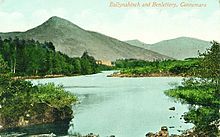Ballynahinch (Galway)
Ballynahinch or Ballinahinch ( Irish Baile na hInse - German "the settlement of the island" ) is a townland in the barony of the same name in the Connemara region in County Galway in western Ireland , on the road from Recess to Roundstone and on the former railway line from Galway to Clifden .
The O'Flaherty clan likely had a fortification on the island in Ballynahinch Lake. In the 13th century he probably founded a Carmelite monastery where the hotel is today . The tower house on the island, which is now destroyed, is said to have been built in 1565 by Dónal O'Flaherty von Bunowen, Grace O'Malley's husband, using stones from the abandoned Toombeola Abbey. In 1584 it was won by the eastern branch of the O'Flaherty clan during a family feud with the western cousins of Murchadh na dTua and later recaptured by the sons of Dónal and Tadhg na Buile, an O'Flaherty of Aird Thoir. In 1585 the old territory of Connemara became the "Barony of Ballynahinch" (the area of the parishes of Clifden, Ballynakill, Roundstone and Cama).
Murchadh na Mart O'Flaherty von Bunowen owned Ballynahinch in 1642. Since he was involved in the rebellion of 1641-1642, Ballynahinch was drafted, along with the rest of the property of the O'Flaherty of the victorious English in the so-called Plantation and with other parts of Connemara, Thomas Merridith, a confidante of Oliver Cromwell assigned who sold them to the Martins , one of the Cambro-Norman families known as the Tribes of Galway . The Martins already owned land in Connemara that had been mortgaged to them by the O'Flahertys. They have been granted more property than what was confiscated in Galway. By clever tactics, they came out of this century with the largest land holdings in Ireland, including over a quarter of a million acres around the manor house at Claremount (now Oughterard ).
The house, later known as Ballynahinch Castle, was built by Robert Martin (1714–1794) as an inn, perhaps as a smuggler's meeting place. His son Richard (1754-1834) known as "Humanity Dick" - he was one of the founders of the RSPCA - and as Hairtrigger Dick (because of his many duels) retired to Ballynahinch in 1793, which he enlarged around 1813. Richard and his son Thomas (1786–1847) ruled their territory in a feudal style. Generations of extravaganza had deeply indebted the property, and the famine of 1845-1849 eventually bankrupted it. Thomas died and his daughter Mary went to Belgium with her husband. The pledged property was auctioned off cheaply by a company. She renovated the house in 1858 and sold it in 1872 with approximately 160,000 acres in Connemara and 10,000 in County Mayo (including Clare Island ) for £ 230,000 to Richard Berridge of Meux Brewery in London. R. Berridges (1803-1887), father was a McCarthy from Kerry , (but took his mother's name) renovated the house but was mostly absent. His son Richard (1870–1941) moved into residence here and in 1908 added a third floor and the terrace to the house. In 1914 the county committee paid him £ 95,441 for 143,325 acres divided among the tenants. In 1925 Berridges sold the house with the remaining land and fishing rights to cricketer Maharaja Rangi Singhi for £ 31,250 and moved to Screebe Lodge. The Maharajah entertained his guests until his death in 1933, when Ballynahinch was sold to a family of Dubliners. In 1946 the Irish Tourist Board bought it and made it the Ballinahinch Castle Hotel. In 1957 it was sold to the American Edward Bell and is now in American ownership.
literature
- Tim Robinson: Connemara Part 1: Introduction and Gazetter Roundstone 1990 ISBN 0-9504002-5-4
Coordinates: 53 ° 27 '30 " N , 9 ° 51' 50" W.
